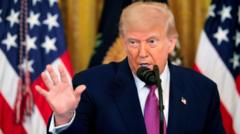In a pivotal moment for Canada, citizens are casting their votes to determine the future direction of their government amidst rising tensions with the U.S. The Conservative Party, once a frontrunner, faces challenges as the Liberal Party led by Mark Carney gains momentum from discontent with former Prime Minister Justin Trudeau's legacy and the repercussions of President Trump’s aggressive trade policies.
**Canada's Election at a Crossroads: Who Will Reign Amid U.S. Tensions?**

**Canada's Election at a Crossroads: Who Will Reign Amid U.S. Tensions?**
As the Canadian election unfolds, the impact of U.S. politics looms large, shaping voter preferences and party fortunes.
The polls, which opened staggered across the nation’s six time zones, signal a crucial election day with implications for governance and economic stability. The stakes are high as Canadians choose their representatives, grappling with the issues of economic stability, immigration policies, and national sovereignty.
The political landscape shifted dramatically in the months leading to this election, largely due to Trump's threats and tariffs that destabilized Canada's economy, prompting a reevaluation of party leadership among voters. Election forecasts initially favored Conservative leader Pierre Poilievre, but recent trends indicate the Liberals' resurgence as voters seek a more moderate approach to U.S. relations under Carney's experienced guidance.
Beyond the two dominant parties, the New Democratic Party and the Bloc Québécois also vie for seats but face dwindling chances as the main contest narrows between Carney and Poilievre. The electoral system functions on a riding basis, where the party that wins the most seats in the House of Commons ultimately forms the government, setting the tone for Canadian legislation for years to come.
As the afternoon progresses, voters reflect, revealing deep concerns over economic challenges exacerbated by Trump's policies and a growing housing crisis across urban centers. Carney, with his background in central banking, presents himself as a steady hand capable of navigating these turbulent waters while Poilievre's populist appeal struggles to resonate beyond his party’s base, particularly in regions wary of Trump's influence.
The outcome of this election holds significant weight for Canada and its standing in global affairs, especially regarding its delicate relationship with the United States. With results expected late tonight, the nation watches closely as it seeks a new leader to guide it forward.
The political landscape shifted dramatically in the months leading to this election, largely due to Trump's threats and tariffs that destabilized Canada's economy, prompting a reevaluation of party leadership among voters. Election forecasts initially favored Conservative leader Pierre Poilievre, but recent trends indicate the Liberals' resurgence as voters seek a more moderate approach to U.S. relations under Carney's experienced guidance.
Beyond the two dominant parties, the New Democratic Party and the Bloc Québécois also vie for seats but face dwindling chances as the main contest narrows between Carney and Poilievre. The electoral system functions on a riding basis, where the party that wins the most seats in the House of Commons ultimately forms the government, setting the tone for Canadian legislation for years to come.
As the afternoon progresses, voters reflect, revealing deep concerns over economic challenges exacerbated by Trump's policies and a growing housing crisis across urban centers. Carney, with his background in central banking, presents himself as a steady hand capable of navigating these turbulent waters while Poilievre's populist appeal struggles to resonate beyond his party’s base, particularly in regions wary of Trump's influence.
The outcome of this election holds significant weight for Canada and its standing in global affairs, especially regarding its delicate relationship with the United States. With results expected late tonight, the nation watches closely as it seeks a new leader to guide it forward.























